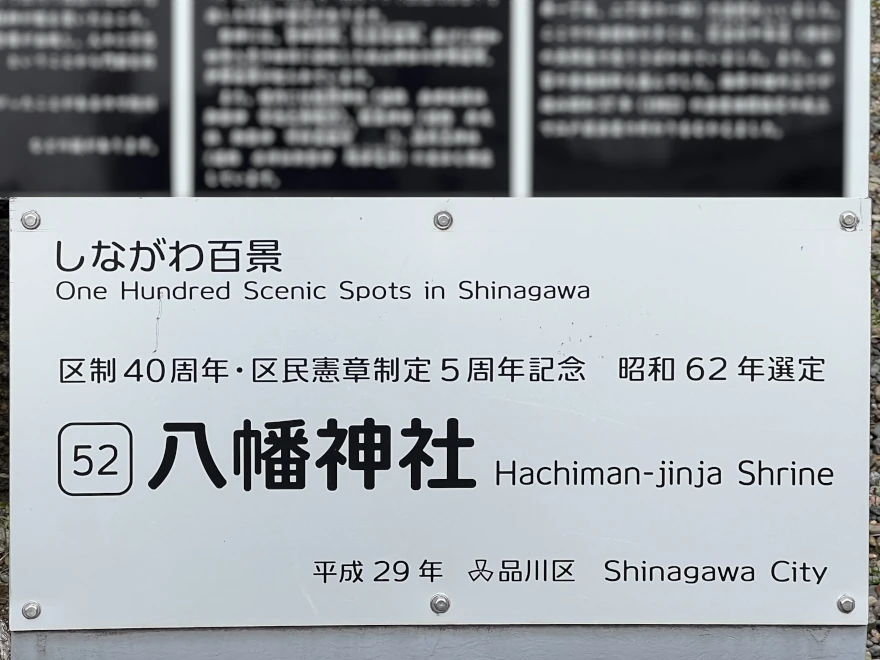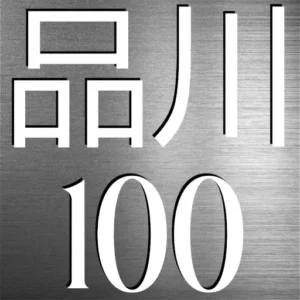⛩️ Hachiman Shrine – Guardian of the Seaside Fishermen
Hachiman Shrine (八幡神社), also known as Samezu Hachiman Shrine (鮫洲八幡神社), stands in Samezu, a historic fishing village in Shinagawa’s Ōi district. The shrine was once called Ohayashi Hachiman-gū (御林八幡宮), reflecting the area’s special status as shogunate-managed land. Samezu’s roots trace back to the 17th century, when fishermen were relocated here from Shiba-Kanasugi to make way for a daimyo estate. This newly formed fishing village, called 御林町 (Ohayashi Town), fell under direct Tokugawa protection and played a vital role in supplying fresh seafood to Edo Castle.
Although the exact founding date of the shrine is unknown, records show that it already existed during the Kanbun era (1661–1673). Hachiman Shrine enshrines Homudawake no Mikoto (Emperor Ōjin), Okinagatarashihime no Mikoto (Empress Jingū), and the creator gods Izagani no Mikoto and Izanami no Mikoto.
🎣 A Shrine Born from the Sea
Samezu’s fishermen depended on Hachiman Shrine for protection as they braved the unpredictable waters of Tokyo Bay. So familiar were they with sharks that the village itself came to be known as Samezu (鮫洲), meaning “Shark Sandbank.” As part of the 御菜肴八ヶ浦 (Osai Sakana Hachikaura)—eight villages officially tasked with supplying seafood to the shogunate—Samezu enjoyed privileged status but carried heavy obligations. During festivals, villagers carried the shrine’s mikoshi not only through the streets but once even into the sea, celebrating their bond with the bay that sustained them. Although sea processions have ended, echoes of this tradition still shape Samezu’s strong maritime identity today.
🏮 Reconstruction and Renewal
Through fires, urban expansion, and societal change, Hachiman Shrine has remained resilient. Major rebuilding took place in 1813, and the current main hall was completed in 1972. Around the precincts, visitors can still find offerings from fishermen: stone lanterns (1856), komainu guardian dogs (1849), and weathered stone walls built to protect the sacred grounds from salt and storm.
Moreover, tucked within the grounds are several charming subshrines. These include Inari Shrine, Nagotama Shrine (dedicated to water spirits), Itsukushima Shrine (Benzaiten), and notably, the small Shark Shrine (鮫祠). Reflecting the fishermen’s bond with the sea, the Shark Shrine honours the spirit of the ocean’s fiercest guardian and underlines Samezu’s deep maritime heritage.
🎐 Festival Traditions of Samezu
The shrine’s annual festival spans the Friday, Saturday, and Sunday closest to August 14. For early risers, there’s 3:00 AM mikoshi departure on Saturday—a dramatic ritual echoing the early morning departures of Edo-period fishermen. And, participants must switch to special short poles and carefully manoeuvre the mikoshi beneath the shrine’s low torii gate, adding a unique Samezu flavour to the festival atmosphere.
🌊 The Legacy of 御菜肴八ヶ浦
Samezu was one of the prestigious 御菜肴八ヶ浦 (Osai Sakana Hachikaura)—eight fishing villages responsible for supplying fresh seafood directly to Edo Castle. These villages enjoyed special protections but were obligated to provide regular tribute. They were:
- 本芝 (Honshiba) – modern Shiba, Minato City
- 芝金杉 (Shiba-Kanasugi) – near present-day Shibaura, Minato City
- 品川 (Shinagawa) – Shinagawa area, Shinagawa Ward
- 御林 (Ohayashi/Samezu) – Higashi-Ōi, Shinagawa Ward
- 羽田 (Haneda) – Haneda, Ōta Ward
- 生麦 (Namamugi) – Namamugi, Tsurumi Ward, Yokohama
- 神奈川 (Kanagawa) – Kanagawa Ward, Yokohama
- 新宿 (Shinshuku/Koyasu) – area around Hodogaya, Yokohama
Being part of the Osai Sakana Hachikaura tied Samezu’s fate closely to the shogunate, shaping its economy, its culture, and the continuing importance of Hachiman Shrine to the community today.
🌀 Shrine Details
Deity (祭神): Homudawake no Mikoto (Emperor Ōjin), Okinagatarashihime no Mikoto (Empress Jingū), Izagani no Mikoto, Izanami no Mikoto
Founding: Early Kanbun era (1661–1673)
Annual events: Samezu Hachiman Shrine Festival (Friday–Sunday closest to 14 August)
Special features: Shark Shrine (鮫祠), sea-themed mikoshi traditions, low torii gate requiring special mikoshi carrying poles.
Once the guardian of a seaside fishing community, Hachiman Shrine preserves the spirit of Samezu’s maritime history. Rituals like the 3AM mikoshi departure and the dedication to sharks reflect a deep and enduring connection between shrine, sea, and village life.
🧭 Visitor Information
Address: 1-20-10 Higashi-Oi, Shinagawa City, Tokyo 140-0011
Best season: Summer (Festival in August)
Admission: Free
Official Info: Samezu Festival Association
Note: Please respect shrine grounds and local customs during festivals. Stay clear of mikoshi routes when parades are underway.
Where is it?
| what3words | ///miles.beefed.grass |
| latitude longitude | 35.60468 139.74258 |
| Nearest station(s) | Samezu Station (Keikyu Main Line) |
| Nearest public conveniences | Public toilets near Samezu Park |
Show me a sign.

Yes! This site proudly displays its Shinagawa Hyakkei sign near the torii gate, acknowledging its role in maritime and local history.
Withervee says…
3AM? I’ve not got around to seeing that yet.
One of the few Hyakkei spots with its original sign intact — bonus points. Serene, salty-aired, and still beating with neighbourhood life. A lovely moment between errands or train changes.
Site Character
- Lifestyle 生活 (Seikatsu): ✔️
- Historical Significance 歴史 (Rekishi): ✔️
- Atmosphere/Natural Features 風土 (Fūdo): ✔️
Who in their right mind would vote for this?
- Festival lovers
- Maritime history buffs
- Shrine pilgrims
- Old Tōkaidō wanderers
- Early risers
Tokyo Metropolitan Shrine Association – Samezu Hachiman Shrine
While you’re there…
Stroll over to Ōi Kumin Park or explore the retro shopping street near Samezu Station for snacks and local colour.
Previous
Oi

